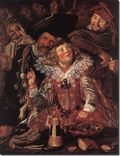02 Oct Telluride Inside… and Out: Hals and Grooms in New York
 These are the faces not just a mother can love and an ethos also easy to relate to. Still, in the case of painter Frans Hals. On Firday, Telluride Inside… and Out visited the Big Apple once again. Our two key stops yesterday: the Frans Hals show at The Metropolitan Museum of Art and the Red Grooms show at the Marlborough Gallery, 40 West 57th Street.
These are the faces not just a mother can love and an ethos also easy to relate to. Still, in the case of painter Frans Hals. On Firday, Telluride Inside… and Out visited the Big Apple once again. Our two key stops yesterday: the Frans Hals show at The Metropolitan Museum of Art and the Red Grooms show at the Marlborough Gallery, 40 West 57th Street.
Though divided by centuries, the two artists have more in common than meets the eye. Hals and Grooms convince with clear-eyed depictions of the human condition. Both became well known for affectionate yet truthful portrayals of the urban cultures of 17th-century Haarlem, the Netherlands, Hal's adopted home, and 20th/21st century New York in the case of Grooms.
 All roads leading to the dawn of modernity, Impressionism, and the works of artists such as Manet, Monet, Van Gogh, James McNeill Whistler, Mary Cassett and John Singer Sergeant, lead back to Hals. These iconic painters held Hals in the highest regard for his winning combination of life, lucid and unfiltered, light, ditto, and fluid brushwork. Quotes from the likes of Van Gogh make strong points about Hals, one noting the fact he had a repertoire of 27 shades of black. (Eat your heart out Ad Reinhardt.)
All roads leading to the dawn of modernity, Impressionism, and the works of artists such as Manet, Monet, Van Gogh, James McNeill Whistler, Mary Cassett and John Singer Sergeant, lead back to Hals. These iconic painters held Hals in the highest regard for his winning combination of life, lucid and unfiltered, light, ditto, and fluid brushwork. Quotes from the likes of Van Gogh make strong points about Hals, one noting the fact he had a repertoire of 27 shades of black. (Eat your heart out Ad Reinhardt.)
Frans Hals (1582 – 1666) was part of the trio rock stars who dominated the Golden Age of Dutch Painting. The other two players were Rembrandt and Vermeer. The show, organized by the Met's curator of Dutch and Flemish painting, Walter Liepke, succeeds not only in illuminating this high moment in the history of art, but also the institution's own evolution. Many of the Hals were acquired the year after the Met was incorporated, 1871, from collectors who comprised the Who's Who of America's Gilded Age, predisposed to the artist because of the admiration of the aforementioned 19th-century artists. Kind of like "takes one to know one."
Hals not only anticipated modernism, 100s of years before the advent of photography, his ability to capture people in motion with candor presaged the so-called Kodak moment.
Hals' ability to depict real people doing things real people did back then was nearly unparalleled in his time. The same holds true for Grooms (b. 1937) in his day.
Red Grooms has staked his claim as one of America's most original, inventive and popular artists, known for his witty commentaries on modern life. (The first gallery in the Hals show in particular, rife with noise and bawdy innuendo, reveals the exact same gift for satire.) Groom's "Porno Bookstore," for example, is a colorful and irreverent, near life-size installation that could make even a jaded New Yorker blush. The viewer centers the two constructed rooms of the "store" to browse the comically detailed merchandise along with the "patrons" Grooms created. Among the canvases on display at the Marlborough is the memorable "Arbus at The Met," a 2007 oil in which Grooms takes the subjects of Diane Arbus's famous photographic portraits and places them at the Met amidst an Arbus exhibition, where they meet and mingle as they never have before, fulfilling a Groomsian fantasy. The main characters from the Arbus photos are now part of the pop-lexicon of American life: Tiny Tim, Andre the Giant, and the Kennedy supporter.
Hals are Grroms are gems, well curated, small and not to be missed. Hals runs through October 10. (Get the audio tour. It's chock full of illuminating, fun information.) The Grooms show, an overview of the artist's work from 1976– 2011, continues through October 22.


Sorry, the comment form is closed at this time.